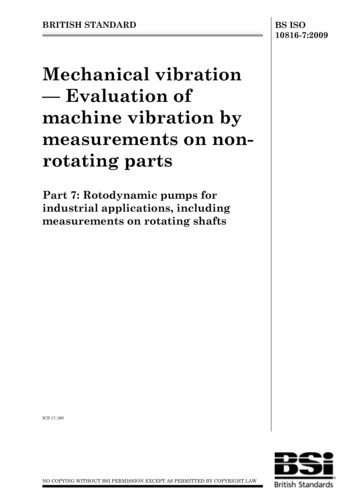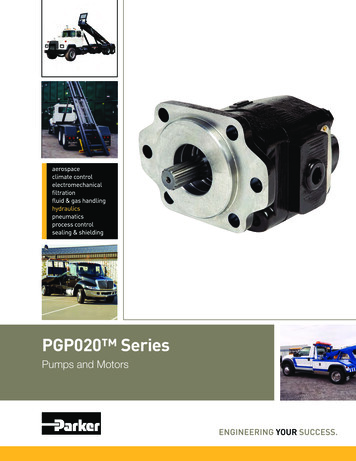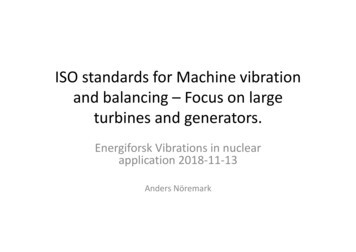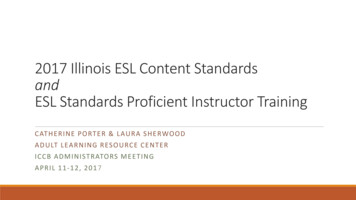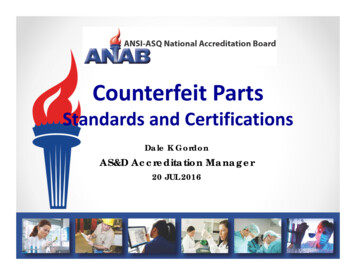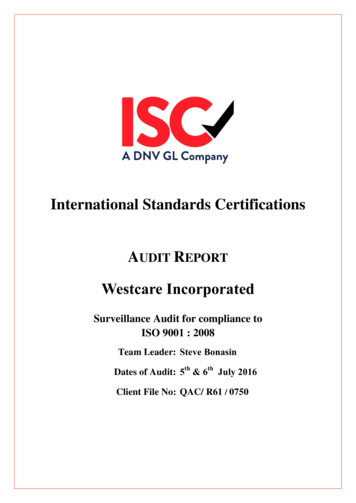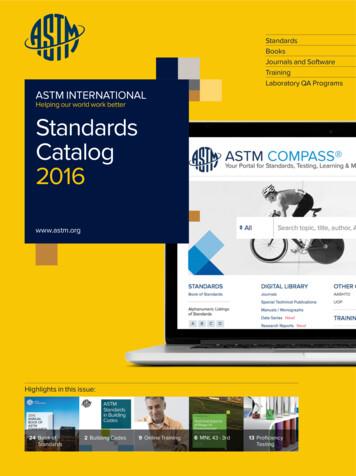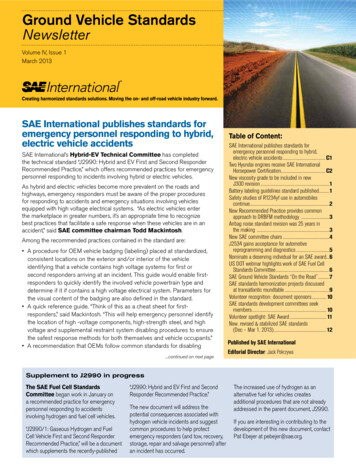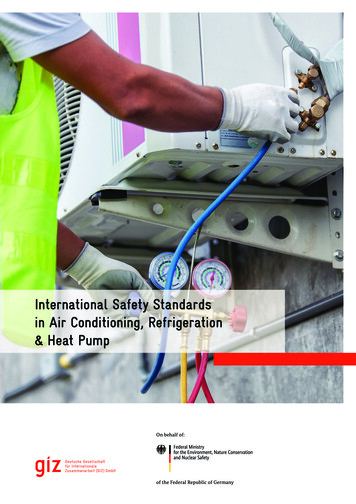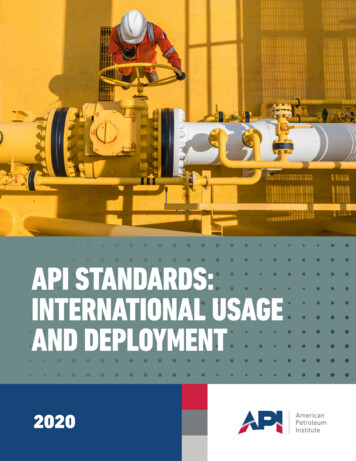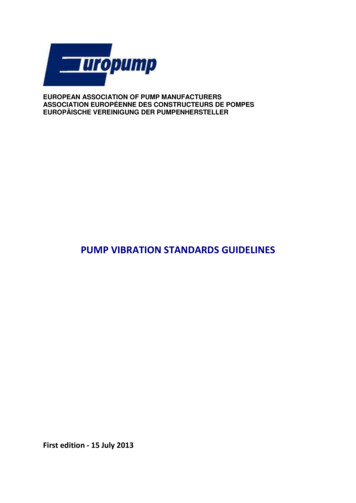
Transcription
EUROPEAN ASSOCIATION OF PUMP MANUFACTURERSASSOCIATION EUROPÉENNE DES CONSTRUCTEURS DE POMPESEUROPÄISCHE VEREINIGUNG DER PUMPENHERSTELLERPUMP VIBRATION STANDARDS GUIDELINESFirst edition - 15 July 2013
Pump vibration standardsINTRODUCTIONThe diversity of standards applicable to the pump industry is probably greater on the subject ofvibration than any other field.These standards can appear to be conflicting in that they present machine vibration limits indifferent ways and with different limiting values.The purpose of these guidelines is to present, in one document, the essential points of eachstandard and to explain where each standard tends to be used.This document is not an alternative to studying the full content of the standard with whichcompliance is required, and because it is a summary, does not contain all the conditional statementsand explanations which are in the standard itself.A previous Europump guideline written some years ago, before the diversity of national andinternational standards occurred, recommended vibration limits for pumps. Europump iswithdrawing this guideline because it does not want to add to the diversity of pump vibrationstandards.SCOPEThe standards included in these guidelines are applicable to rotodynamic pumps only and do notinclude guidance or vibration levels of drivers that may be part of the pump set.The vibration limits apply to pumps with multi-vaned impellers. Pumps specifically designed forsolids handling and waste water applications will experience higher out of balance forces andpressure pulsations with subsequently increased vibration levels.2
Pump vibration standardsContents1.SUMMARY OF STANDARDS . 51.1.1.1.1.1.2.1.2.1.1.3.1.3.1.ISO 9908 - Technical specification for centrifugal pumps – Class 3 . 5Application of this Standard. 5ISO 5199 –Technical specification for centrifugal pumps Class II . 5Application of this Standard. 6ISO 9905 - Technical specification for centrifugal pumps – Class 1 . 6Application of this Standard. 71.4. ISO 10816-3 - Mechanical vibration – Evaluation of machine vibration by measurementson non rotating parts . 71.4.1.Application of this Standard. 71.5. BS ISO 10816-7 - Mechanical vibration - Evaluation of machine vibration bymeasurements on non-rotating parts. 81.5.1.Application of this Standard. 91.6. ISO 13709 2009 Centrifugal pumps for petroleum, petrochemical and natural gasindustries also a dually numbered as API 610 . 101.6.1.2.Application of this Standard. 12COMPARISON OF PERMITTED VIBRATION LEVELS . 133
Pump vibration standardsACKNOWLEDGEMENTSPermission to reproduce extracts from British Standards is granted by The British StandardsInstitution (BSI). No other use of this material is permitted. British Standards can be obtained in PDFor hard copy formats from the BSI online shop: www.bsigroup.com/Shop or by contacting BSICustomer Services for hard copies only: Tel: 44 (0)20 8996 9001, Email: cservices@bsigroup.comExtracts shall not be used as part of any other work.Only English Language use of the extracts is permitted.The publication including the extracts is only available for download from Europump website (http://www.europump.org/ )The standards are also EN Standards and are issued as standards from European National StandardsOrganizations, but because this guide is in English, extracts are taken from BS EN ISO versions.The guide is based on the version of the standards which were current at the date of publishing.4
Pump vibration standards1. Summary of Standards1.1. ISO 9908 - Technical specification for centrifugal pumps – Class 3This standard covers requirements for centrifugal pumps of single stage, multistage, horizontal orvertical construction (coupled or close coupled)Class 3 requirements considered less severe than ISO 5199.Conditions:A) Vibration severity refers measurements at test facilityB) Differentiates between pumps with centreline heights above and below 225 mm and speedsup to 1800 rpm and 1800 to 4500 rpmC) Values measured radially at bearing housing at a single operating point at rated speed( /- 5%) and rated flow ( /- 5%) operating without cavitationD) Vertical lineshaft pumps have readings at the top flange when rigid couplings are employedand near the top pump bearing for pumps with flexible couplingsE) Limits for both rolling and sleeve bearing pumps shall not exceed a velocity of 7.1 mm/s1.1.1. Application of this StandardThis standard is applied to any light duty centrifugal pump, but is most commonly associated withend suction pumps to EN733.1.2. ISO 5199 –Technical specification for centrifugal pumps Class IIThis standard covers Class II centrifugal pumps of single stage, multistage, horizontal or verticalconstruction with any drive and any installation for general application. Pumps used in thechemical industry are typical of those covered by this standard.5
Pump vibration standardsConditions:A) All major rotating components shall be balancedB) Vibration limits should be achieved by balance to grade G6.3 of ISO 1940-1C) Vibration severity refers measurements at test facilityD) Differentiates between pumps with centreline heights above and below 225 mm, and also :1) Rigid horizontal2) Flexible horizontal3) All verticalRms velocity mm/sC/L height 225 mmC/L height 225 mmRigidhorizontalFlexiblehorizontalAll vertical3.004.505.507.107.107.101.2.1. Application of this StandardThis standard is applied to any medium duty centrifugal pump, but is most commonly associatedwith end suction pumps to ISO 2858, which are used in chemical and industrial applications,including aggressive, toxic, high temperature duties.1.3. ISO 9905 - Technical specification for centrifugal pumps – Class 1This standard covers the Class I (most severe) requirements for centrifugal pumps in variousindustries, but does not apply to pumps used in petroleum, petrochemical or natural gasapplications.Conditions:A)B)C)D)All major rotating components shall be balanced.Vibration limits should be achieved by balance to grade G6.3 of ISO 1940-1.Vibration severity refers measurements at test facilityPump and driver vibration performance will be as good on permanent foundation as on teststand.6
Pump vibration standardsE) Differentiates between pumps with centreline heights above and below 225 mm and speedsup to 1800 rpm and 1800 to 4500 rpm.F) Values measured radially at bearing housing at a single operating point at rated speed ( /5%) and rated flow ( /- 5%) operating without cavitation.Vertical lineshaft pumps have readings at top flange when rigid couplings are employed and near thetop pump bearing for pumps with flexible couplings.Limits for both rolling and sleeve bearing pumps shall not exceed a velocity of 7.1 mm/s.1.3.1. Application of this StandardThis standard is applied to heavy duty centrifugal pumps for arduous duties such as hightemperature or high pressure, but the standard is not intended for petroleum, oil and gas industries.1.4. ISO 10816-3 - Mechanical vibration – Evaluation of machinevibration by measurements on non rotating partsPart 3 – Industrial machines with nominal power above 15 kW and nominal speedsbetween 120 r/min & 15000 r/min when measured in situ.1.4.1. Application of this StandardThis Part of ISO 10816 is no longer to be used as the vibration standard for pumps; it has now beensuperseded by part 7.7
Pump vibration standards1.5. BS ISO 10816-7 - Mechanical vibration - Evaluation of machinevibration by measurements on non-rotating partsPart 7: Rotodynamic pumps for industrial applications, incl. measurements on rotatingshafts.The standard covers rotodynamic pumps for industrial applications with nominal power above 1kW.It includes vibration measurement on rotating and non-rotating parts (bearing housing vibration)and provides guidance for vibration severity in situ and at the manufacturer’s facility for ‘Preferred’and ‘Allowable’ operating ranges. The differentiation between solid & flexible mountings which wasused in part 3, is not made.Pumps are classified in two categories:Category IPumps required to have a high level of reliability, availability or safety reasons, (e.g.pumps for toxic and/or hazardous liquids, for critical application, oil & gas, special chemical nuclearor power plant applications).Category IIPumps for general or less critical applications (e.g. pumps for non-hazardous liquids).Vertical suspended pumps with speeds above 600 rpm usually Category IIThe standard defines Zone limits for vibration of non-rotating parts of rotodynamic pumps, withpower above 1 kW, and impeller vanes greater than 3.The zone descriptions are:Zone A Vibration of newly commissioned machines.Zone B Acceptable for unrestricted long-term operation.Zone C Unsatisfactory for long term continuous operationZone D Vibration of sufficient severity to cause damage to machine.Operating ranges:8
Pump vibration standardsThe AOR & POR are to be indicated by pump manufacturer. (The POR is in general 70% to 120% ofBEP). Higher vibration values may occur outside the AOR. These values may be tolerated for shortterm operation, but for continuous operation, damage or premature wear could occur.If the background vibration, with pump not running, exceeds 25% of the value measured with thepump running, corrective action may be necessary to reduce the effect of background vibration.Limits for Vibration measured in non-rotating partsVibration velocity limitmm/s rms valueCategory 1ZoneDescriptionNewly commissioned machines inAPORUnrestricted long term operationBin AORCLimited operationDHazard damageMaximum ALARM limit( 1.25 times upper limit of zone B)¹Maximum TRIP limitCategory 2 200 kW 200 kW 200 kW 200 kW2.53.53.24.24.06.6 6.65.07.6 7.65.18.5 8.56.19.5 5.28.3( 1.25 times upper limit of zone C)¹Preferred operating2.5In situ acceptance rangetestAllowable operatingrange3.4Preferred operating3.3Factory acceptance rangetestAllowable operatingrange4.0¹ Recommended values. Vibration magnitudes should bebefore an Alarmor Trip is released, to avoid false alarms and trips.For filtered levels see the standard.5.05.16.1above these levels for about 10 s1.5.1. Application of this StandardThis is the latest part of this standard whose development was led by User Industries. It can beapplied to most multi-vane impeller pumps.The standard identifies Category I and II pumps.It implies that pumps in hazardous applications fall into Category I but this is in conflict withhistorically applying ISO 5199 to the pumps in very demanding chemical applications.9
Pump vibration standardsMajor manufacturers in Europump recommend that chemical pumps to ISO 2858 which generallycomply with the technical feature in other parts of ISO 5199 should also comply with the vibrationlevels in ISO 5199 or, if ISO10816 part 7 is used, then Category II is the appropriate part.The standard defines that vertical pumps are in Category II. This standard and category may imposeunnecessarily low limits for some vertical pump designs and applications or where operation isintermittent or non-demanding. Here again ISO 5199 is the appropriate standard.1.6. ISO 13709 2009 Centrifugal pumps for petroleum, petrochemicaland natural gas industries also a dually numbered as API 610In this standard, vibration limits are applied during the performance tests and reference ismade to the Preferred Operating range and the Allowable Operating range in the relationshipbetween flow and vibration. The allowable operating region is to be stated. If the allowableoperating region is limited by a factor other than vibration, then that factor is to be stated.10
Pump vibration standardsa) Vibration limits for overhung and between bearings pumps, power up to 300 kW per stage,speed up to 3600 r/min for all bearing types, measured on the bearing housingVelocity(mm/s RMS)OverallDiscrete frequenciesPORAOR3.02.03.92.6b) Vibration limits for overhung and between bearings pumps, for hydrodynamic journal bearings,measured on the pump shaftAmplitude(µm peak to peak)OverallDiscrete frequenciesNot to exceed50.0016.50The above criteria show the allowable increase in vibration of 30%, at flows outside the preferred range but within the allowableoperating region.c) Vibration limits for vertically suspended pumps, for all bearing types measured on the thrustbearing housingVelocity(mm/s RMS)OverallDiscrete frequenciesPORAOR5.03.46.54.4d) Vibration limits for vertically suspended pumps, for hydrodynamic journal bearings measuredon the shaftAmplitude(µm peak to peak)OverallDiscrete frequenciesNot to exceed100.0075.00The above criteria show the allowable increase in vibration of 30%, at flows outside the preferred range but within the allowableoperating region.11
Pump vibration standardse) Vibration Limits for Horizontal pumps absorbing more than 300 k
1.5. BS ISO 10816-7 - Mechanical vibration - Evaluation of machine vibration by measurements on non-rotating parts Part 7: Rotodynamic pumps for industrial applications, incl. measurements on rotating shafts. The standard covers rotodynamic pumps for industrial
